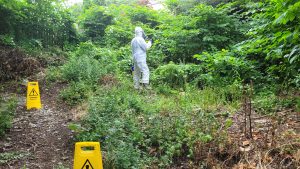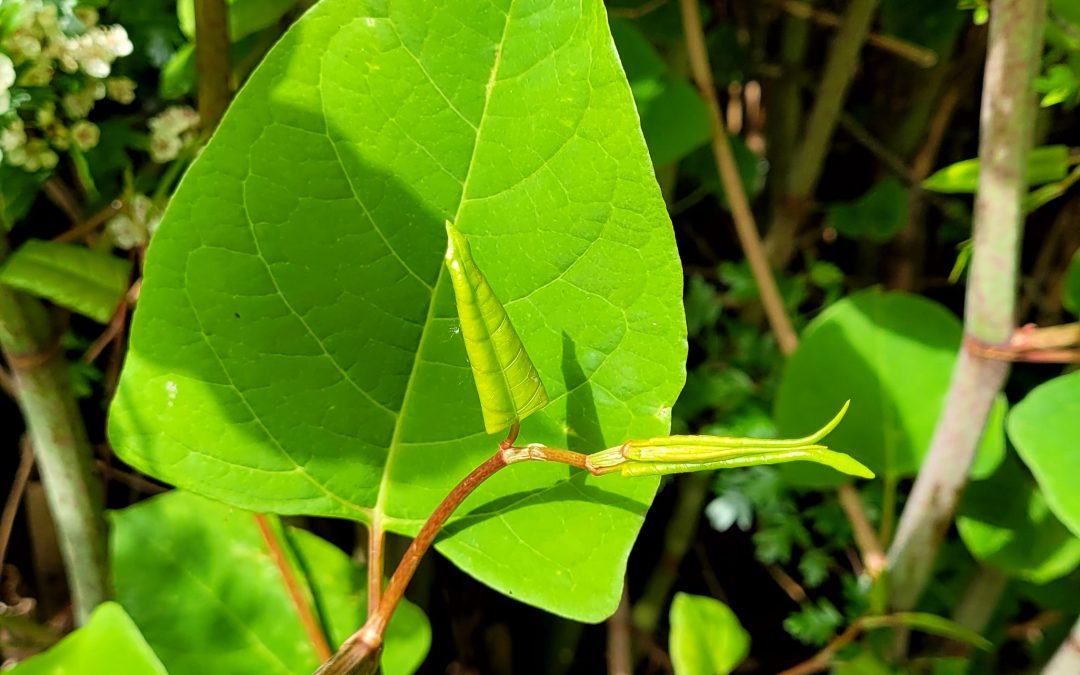What is the natural enemy of Japanese knotweed?
In its native range in Japan,
Japanese knotweed (Fallopia japonica) is not as aggressive and problematic as it is in regions where it has been introduced, like the UK and North America. This is because in Japan, the plant is kept in check by its natural enemies, such as insects, pathogens, and herbivores, which co-evolved with the plant and help regulate its population. so what is the natural enemy of Japanese knotweed ?
However, when Japanese knotweed is introduced to new regions where these natural enemies are absent, it can rapidly spread and become invasive, outcompeting native plant species and causing significant environmental and economic damage.
In its native range in Japan, Japanese knotweed (Fallopia japonica) is part of the natural ecosystem and may serve as a food source for certain animals. However, in regions where it has been introduced as an invasive plant, its consumption by native animals is generally limited.
Japanese knotweed contains high levels of oxalates and tannins, which can make the plant unpalatable and potentially toxic to many herbivores. These compounds can cause digestive issues and reduce the nutrient value of the plant as a food source.
So what is the natural enemy of Japanese knotweed?
While there are some reports of certain animals feeding on Japanese knotweed in invaded regions, their consumption is generally limited compared to native plants that are better suited for their diets. Additionally, the presence of Japanese knotweed can negatively impact native vegetation and reduce the availability of preferred food sources for local wildlife.
In some cases, animals may turn to eating Japanese knotweed when other food sources are scarce or when it becomes established in disturbed or urban environments where natural vegetation options are limited.
Overall, while Japanese knotweed is not a preferred or significant food source for most animals in invaded regions, its aggressive growth and dominance can have negative effects on native wildlife and their habitats. Controlling and managing Japanese knotweed is crucial to protecting local ecosystems and maintaining the biodiversity of native plant species that are more beneficial for wildlife.

big stand of knotweed
In areas where Japanese knotweed has become invasive, efforts have been made to find and introduce natural enemies from its native range to help control its growth. Biocontrol, or the use of natural enemies to manage invasive species, is a strategy that has been considered for Japanese knotweed.
One example of a potential natural enemy is the Japanese knotweed psyllid (Aphalara itadori). This insect is native to Japan and feeds exclusively on Japanese knotweed. When introduced to areas outside Japan, it has shown promising results in reducing the growth and reproductive capacity of the plant.
However, it’s important to note that the introduction of biocontrol agents requires careful consideration and rigorous testing to ensure that they do not become invasive themselves or cause unintended harm to native plants or ecosystems.
Currently, biocontrol agents are not widely used or established as a primary method for Japanese knotweed management.
The primary approach for controlling Japanese knotweed remains a combination of chemical treatment, excavation, and continuous monitoring and management by qualified professionals.”
-
Japanese knotweed (Fallopia japonica):
- This is an invasive plant species originally from East Asia. Introduced to other parts of the world, it has caused significant ecological and infrastructural issues due to its rapid growth and resilient nature. Once established, it can damage roads, buildings, and other structures, making its control very important.
-
Chemical Treatment:
- Herbicides: The most common method for treating Japanese knotweed is the use of specific herbicides. Glyphosate is often the active ingredient used to treat knotweed because of its effectiveness. It is absorbed by the plant and works its way to the roots, thereby killing the entire plant.
- Timing: Treatment is often most effective during the late summer or early autumn when the plant is transporting nutrients to its roots.
- Repeated Applications: A one-time application is usually not enough. Multiple treatments are often required to ensure that the entire root system has been killed.
-
Excavation:
- This involves physically removing the plant and its extensive root system from the ground.
- Deep Roots: Japanese knotweed has a robust rhizome (root) system which can extend several meters deep and spread out widely. If even a small section of the root remains, it can regrow.
- Disposal: The removed plant material must be disposed of carefully to prevent its spread. In many areas, it’s considered controlled waste, meaning it can’t just be dumped anywhere as it could re-establish.
-
Continuous Monitoring and Management:
- Because of the resilience of Japanese knotweed, even after chemical treatment and excavation, there’s a risk of the plant returning.
- Monitoring: Regular inspections of the treated area are necessary to check for signs of new growth. Early detection allows for immediate action before the plant becomes re-established.
- Management Plan: A long-term management plan may be required, especially in areas prone to Japanese knotweed re-infestation. This plan will outline steps for regular inspections, follow-up treatments, and other necessary actions.
-
Qualified Professionals:
- Expertise: Dealing with Japanese knotweed is not a straightforward task. Qualified professionals have the necessary knowledge and experience to tackle this invasive plant effectively.
- Legal Implications: In many places, there are regulations and laws concerning the treatment and disposal of Japanese knotweed. Professionals are aware of these regulations and can ensure compliance.
- Safe Application: The use of chemicals can have environmental implications, so professionals can ensure they’re used safely and effectively.
Controlling Japanese knotweed
Requires a multifaceted approach combining chemical treatments, physical removal, and diligent observation. Because of the complexities and potential ramifications of handling this invasive species, the involvement of experts in the field is highly recommended.
Here’s why the British climate is favourable for Japanese knotweed:
Japanese knotweed (Fallopia japonica) has found the British climate to be very conducive to its growth, and this has contributed to its invasive spread throughout the UK.
- Temperate Climate: The UK has a temperate maritime climate characterized by mild temperatures and regular rainfall. Japanese knotweed, which originates from East Asia (specifically Japan, China, and Korea), is well-suited to such conditions.
- Rainfall: Regular rainfall in the UK ensures that the soil remains moist, providing the plant with a consistent water supply which aids its rapid growth.
- Lack of Natural Predators: In its native habitat in Asia, Japanese knotweed has natural predators that control its growth. In the UK, the lack of such predators allows it to grow unchecked.
- Soil Types: While Japanese knotweed can adapt to a variety of soil types, it especially thrives in disturbed soils. The UK, with its history of development, land use change, and construction, often provides environments where soils have been disturbed, making them ideal for knotweed colonization.
- Seasonal Growth: Japanese knotweed is a perennial plant. In the spring and summer, it grows vigorously, while in the winter, its above-ground shoots die back, but its rhizomes (underground stems) remain alive. The UK’s distinct seasons align well with this growth pattern, allowing the plant to regrow with vigor each spring.
As a result of these factors, Japanese knotweed has become a significant problem in the UK. Its aggressive growth can damage buildings, roads, and other structures, and it can outcompete native vegetation, leading to ecological disruptions. The challenges posed by this invasive species have led to strict regulations and guidelines for its control and disposal in the UK.
